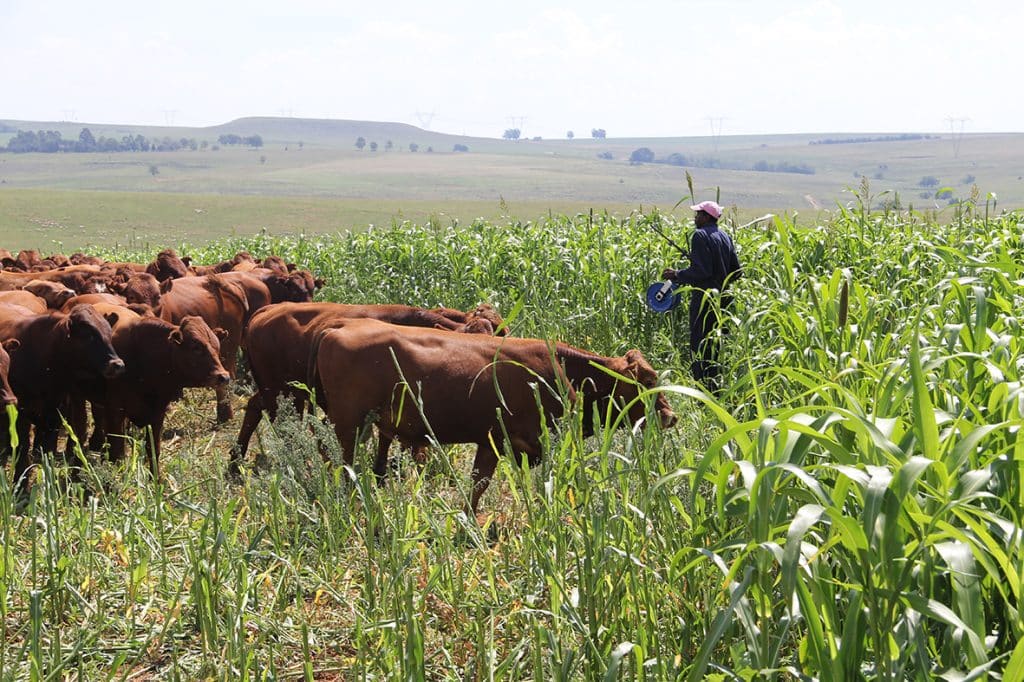Estimated reading time: 7 minutes
- Soil health is a key objective when designing a cover crop mix.
- The soil nutrition web is crucial for keeping soil healthy and making nutrients available to plants. This web consists of bacteria, fungi, protozoa, nematodes, earthworms, multi-legged organisms, and larger animals such as moles.
- Bacteria dominate in most conventional fields, which is why pioneer crops (which are considered weeds) always pose a challenge in conventional systems.
- Cover crop mixes are mostly composed of a combination of crops, each having a different purpose and function in and on the soil.
- Mixes generally consist of four components, namely grasses, legumes, different Brassica species and pollinators.

Soil health is a key objective when designing a cover crop mix. Of course, there can also be other reasons for including certain species in such a mix – these include the time gap between cash crop rotations, the type of livestock to graze the cover crop, the period of utilisation, the cash crop cultivated or to be cultivated before and after the cover crop, disease or soil ecology status, number of flowers required for pollinators, and whether it is on dryland or under irrigation.
Soil is a vibrant and complex ecosystem of microbes and multi-legged organisms. The soil nutrition web is crucial for keeping soil healthy and making nutrients available to plants. This web consists of bacteria, fungi, protozoa, nematodes, earthworms, multi-legged organisms, and larger animals such as moles. Plants secrete sugars through their roots and these sugars then serve as food for bacteria and fungi which, in turn, are food for predators such as protozoa.
The plant retains nutrients that are within reach of the protozoa, which feed on the bacteria and fungi near the root zone of the plant. These bacteria have a much higher nitrogen (N) to carbon (K) ratio than fungi, whereas the latter has a higher N:K ratio than the protozoa that feed on them. The waste excreted by protozoa releases nitrogen which becomes bioavailable to the plant.
Various nutrients
Bacteria dominate in most conventional fields, which is why pioneer crops (which are considered weeds) always pose a challenge in conventional systems. More fungus-dominated soils favour a higher number of succession plants (climax crops) and suppress pioneer crops (which are mostly weeds). That is why you will rarely see ‘weeds’ in a forest of evergreen trees – the highest form of succession.
A mycorrhiza is a symbiotic relationship between fungi and a plant – it is an extension of the plant’s root system and assists in the absorption of nutrients and moisture. The nutrition web also makes minerals available to the plant, enabling it to produce nutrient-dense material. Nutrient density therefore involves more than protein and energy – it also consists of minerals, vitamins, and the secondary metabolites of plants that serve as food for humans and feed for animals.
Cover crop mixes are mostly composed of a combination of crops, each having a different purpose and function in and on the soil. Therefore, the best advice is not to buy a standard mix, but to select each species based on its specific role in the mix. Some species will perform well in a region, while others will not.
Mixes generally consist of four components, namely grasses, legumes, different Brassica species and pollinators.
Annual summer cover crops: Grasses
Sorghums: Sorghums, which are part of the grass component of a summer cover crop mix, produce large volumes of material for grazing and ground cover. It also has a robust root system. Forage sorghums, consisting of sorghum-Sudan types, are favoured over grain sorghums due to their higher biomass production and grazing value.
Some sorghum-Sudan types such as Bargrazer are very good non-host species for root-eating nematodes, which are often a problem due to an unbalanced soil ecology. There is a chance of prussic acid poisoning when sorghum plants experience stress; however, including the crop in a mix of different species will limit this risk.
Babala: Pearl millet or babala, as it is widely known, is also part of the grass component of a cover crop mix. Although babala is a high biomass producer, it produces less than most sorghums but does not pose a prussic acid hazard. Babala has a very strong root system and therefore has a very good effect on soil health.
Hybrid babala: Hybrid millet or hybrid babala has a deep root system and a much longer growing season. Therefore, its regrowth is much better than that of ordinary babala. Hybrid babala forms a big tuft with many leaves. Selecting the correct cultivar is crucial. Some cultivars might be cheaper but they don’t possess the correct characteristics and instead are comparable to an ordinary babala.
Learn more about grass in Grass research to alleviate possible adverse climate changes click here.

Legumes
Dolichos: Dolichos or lablab is a biennial legume utilised mostly as an annual crop. Like other legumes, dolichos make use of rhizobium bacteria, which are in a symbiotic relationship with the plant’s root system, to fix atmospheric nitrogen. Dolichos has an extended growing season and will continue to grow until the winter cold finally kills it off. Each cultivar has a different growing period. For example, Highworth is a short grower and Rongai a longer one. Dolichos produce a high volume of highly digestible material.
Cowpeas: Cowpeas are an annual legume that, like dolichos, bind atmospheric nitrogen. There are different types with different growth patterns – for example creeper types, upright growers and semi-upright types. The specific plant requirement will determine the cowpea cultivar. As a high-protein crop, cowpeas’ grazing value and yield are very good.
Sun hemp: This annuallegume also fixes nitrogen in the soil. It has excellent biofumigation properties against root-eating nematodes. It has an upright growth habit with an average yield compared to cowpeas and dolichos. An advantage of sun hemp is its small yellow flowers which help attract predatory insects to fields.
Sweet clover: Sweet clover (Melilotus alba) is a biennial legume which establishes easily and fixes nitrogen in the soil. The crop has a deep, strong root system and works very well in annual and perennial mixes. Sweet clover produces many flowers for predatory insects and honeybees.
Brassicas
Fodder turnips: Fodder turnips are brassicas with a strong root system and good leaf production for grazing. The deep root system leaves several channels in the soil.
Turnips: These tuberous crops act as miners of phosphates, nitrogen, and sulphur. They retain many of the nutrients in the soil for later release for follow-up crops. Utilising a cultivar suited for summer is crucial.
Radishes and tillage radishes: Japanese radish is a large tuber crop which retains high quantities of phosphates, nitrogen, and sulphur in the soil, making it available for follow-up crops. Tiller radish has a long tuber that leaves deep channels in the soil; it is also known for nutrient storage and release.
Pollinators and others
Buckwheat: Buckwheat is a broad-leaf cereal crop that does not contain gluten protein. Buckwheat can extract nutrients such as phosphates from the soil and make them available. The plant has small white flowers that attract predatory insects and honeybees. It also ranks as one of the top nectar-producing crops for honey production.
Marigold: Marigolds or African marigolds are a well-known flowering plant that attracts predatory insects and secretes a chemical substance that has a suppressive effect on root-eating nematodes.
Sunflower: Sunflower has a deep taproot system and attracts many predatory insects and honeybees to fields. The aforementioned represents a short synopsis of each crop’s role. Producers looking to establish summer cover crop mixes should obtain expert advice when it comes to putting together the correct species in the correct proportion for a specific goal. – Murray Grobler
For enquiries, phone Murray Grobler on 081 038 0282.


